Plants are living organisms that have the same primary objective in life as other beings: to keep living. And because they can’t run away or fight back when predators threaten their existence, they use their poison to deter animals from eating them. There are 646 poisonous plants that grow in North Carolina. They include native and invasive species and can be anything from trees to shrubs to wildflowers. Discover these six dangerous plants that grow in North Carolina and learn about their locations, when they grow, and how they affect pets and humans.
Check out this article next to learn about the most dangerous plants in the United States.
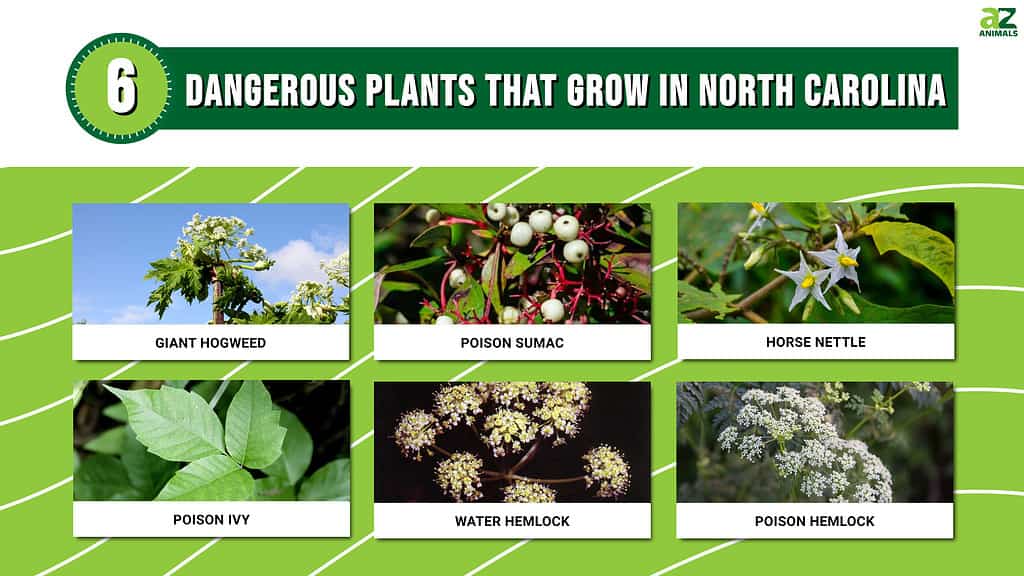
Poison Hemlock (Conium maculatum)
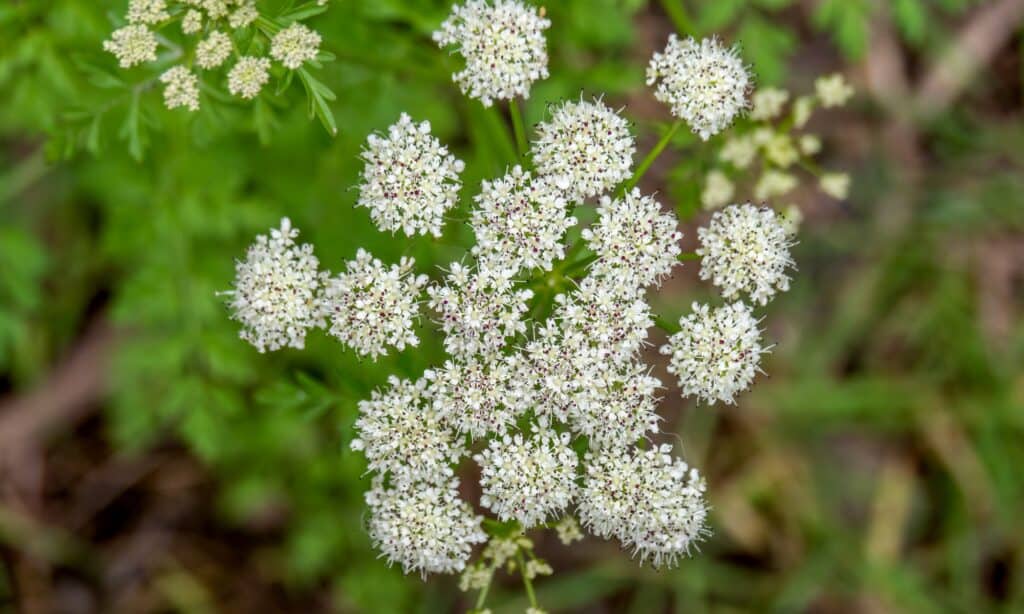
Poison hemlock looks very similar to wild carrot.
©iStock.com/Goldfinch4ever
Names: Deadly hemlock, spotted hemlock, California fern, wild hemlock
When it Grows: This biennial weed belongs to the carrot and parsley family. It begins growing in early spring, taking two years to complete its biological life cycle. Once mature, it can reach heights between six and nine feet tall.
Location: This weed is invasive in North Carolina and can be common near roadsides, ditches, streambanks, and along fences.
How it is Dangerous: All parts of this plant are highly toxic to humans and pets, especially when ingested. They can cause symptoms such as vomiting, salivation, diarrhea, weakness, paralysis, convulsions, coma, and death.
Water Hemlock (Cicuta maculata)
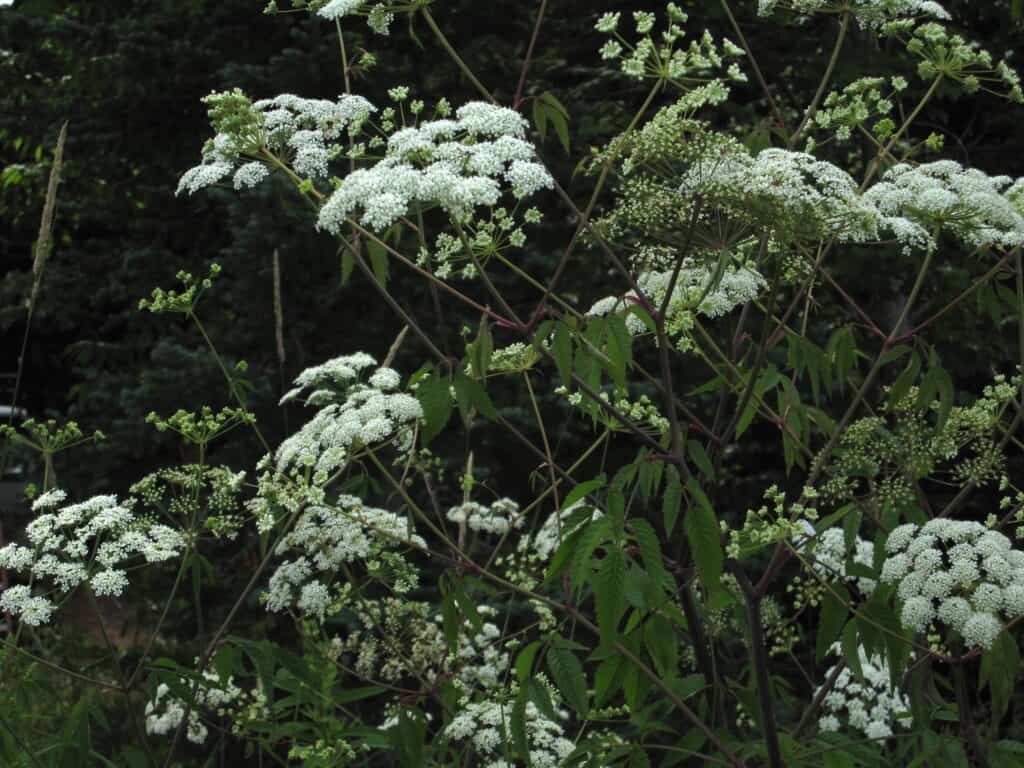
Water hemlock can grow up to 8 feet tall and produces flowers from June to August.
©Williammehlhorn at English Wikipedia, Public domain, via Wikimedia Commons – License
Names: Spotted water hemlock, beaver poison, cowbane, poison parsnip
When it Grows: Perennial herbs that can grow up to 8 feet tall. It sprouts in early spring and flowers from June to August. It is low growing in its first year. But the second year produces a tall stalk. It features small, white flowers in an umbrella cluster. Hemlock is one of the most dangerous plants that grow in North Carolina.
Location: Water hemlock is most common in moist forested areas near ponds, streams, and ditches. Look for them throughout meadows, swamps, and thickets.
How it is Dangerous: This plant is also highly toxic and potentially fatal to humans and pets when ingested. Symptoms include muscle spasms, dizziness, stomach pains, seizures, bloating, fever, and respiratory distress.
Poison Ivy (Toxicodendron radicans)
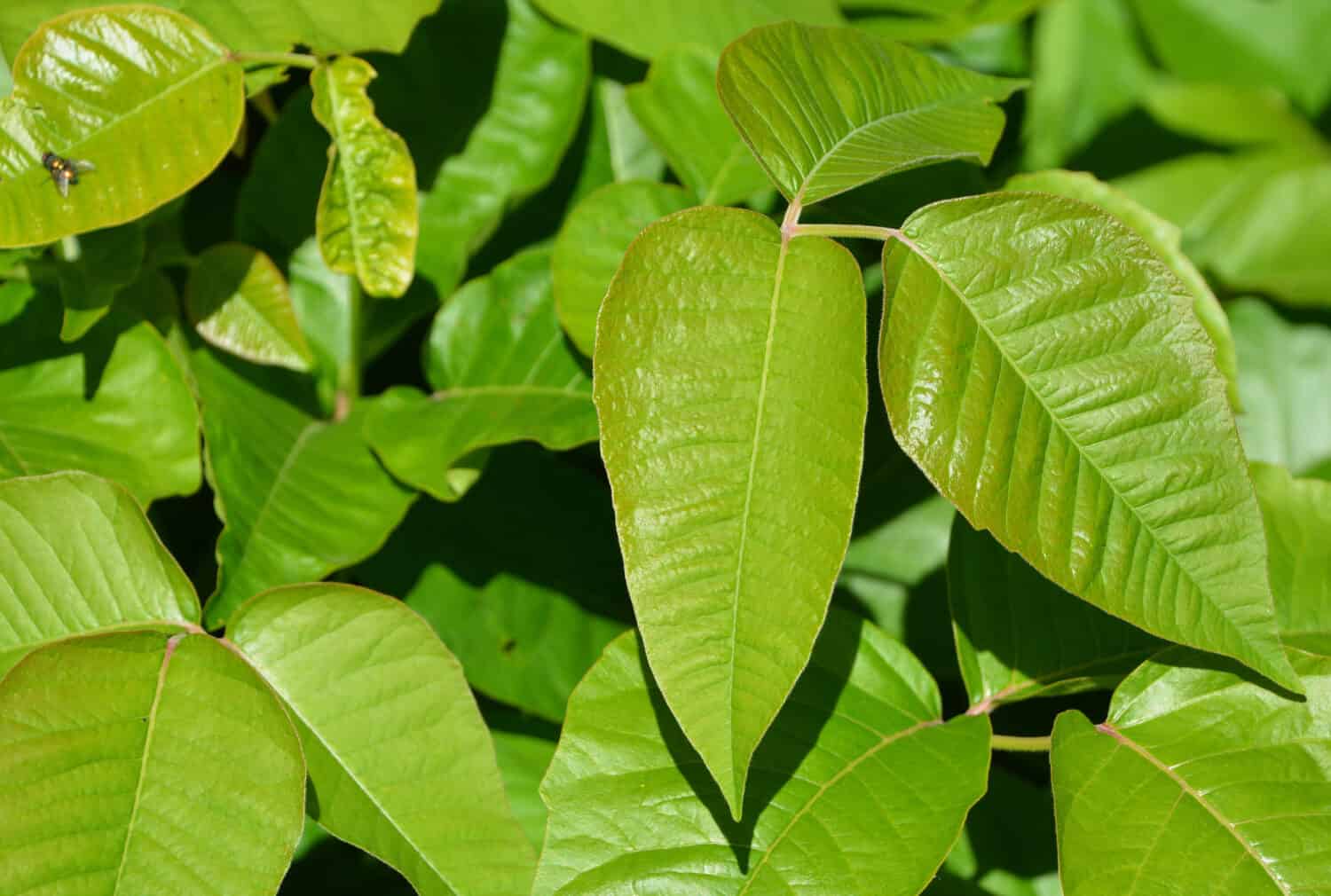
Eastern poison ivy can grow as vines, plants, and shrubs. But produce leaf clusters with three leaflets.
©meunierd/Shutterstock.com
Names: Poison ivy, eastern poison ivy
When it Grows: An allergenic plant belonging to the same family as cashews and pistachios. They are technically not a “true” ivy. They can grow as vines, plants, and shrubs. But produce leaf clusters with three leaflets. Shiny reddish leaves grow in the springs. Small, green flowers bloom from May to July, with white berries growing during the fall.
Location: You can find these plants in many places, including thickets, along fences, wet woodlands, roadsides, and clearings.
How it is Dangerous: All parts of the plant are highly poisonous, with the leaves and bark having a higher concentration. When they come in contact with skin, they can cause inflamed, itchy, and painful blisters.
Horse Nettle (Solanum carolinense)

Carolina
horse
nettle belongs to the nightshade family.
©AsepSur/Shutterstock.com
Names: Carolina horse-nettle, bull nettle, horsenettle
When it Grows: Carolina horse nettle is not true nettle; it belongs to the nightshade family. This herbaceous plant is a warm-season perennial that can grow up to 4 feet tall. The flowers, which look like white and purple stars, bloom during summer and fall. It produces tomato-like fruit. Horse nettle has the highest level of toxins in the fall.
Location: You will find these plants in fields, pastures, and roadsides.
How it is Dangerous: All parts of this plant are highly toxic to humans and pets. If ingested, it can produce symptoms such as nausea, vomiting, diarrhea, stomach pains, sleepiness, muscle weakness, difficulty breathing, coma, and death.
Poison Sumac (Toxicodendron vernix)

The white berries found on poison sumac should make this identification easy.
©G_r_B/Shutterstock.com
Names: Swamp sumac, thunderwood
When it Grows: It grows as a woody shrub or small tree up to 30 feet tall. It is common in the Southern United States and produces clusters of round berry drupes that ripen in late summer and can last through winter.
Location: Poison sumac is found in North Carolin’s coastal plains in marshes, swamps, bogs, or along river banks.
How it is Dangerous: These highly poisonous plants can cause itchy rashes, blisters, fever, coughing, trouble breathing, lung inflammation, lung inflammation, and gastrointestinal inflammation.
Giant Hogweed (Heracleum mantegazzianum)
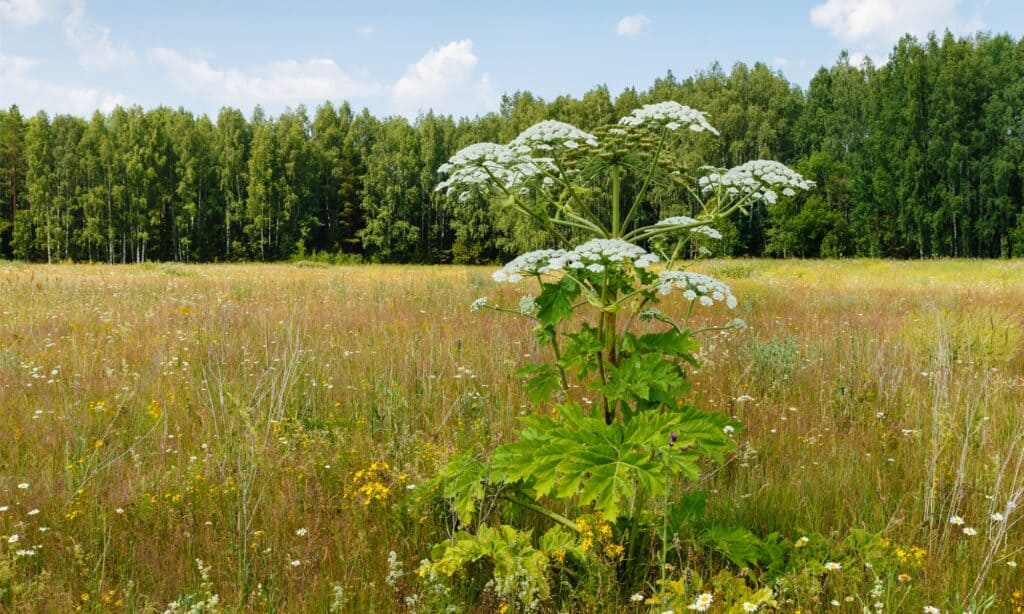
Giant hogweed is invasive in many locations.
©iStock.com/Mieszko9
Names: Cartwheel flower, giant cow parsley, hogsbane, wild parsnip
When it Grows: An herbaceous perennial plant from the carrot family. It is a noxious weed that can grow 20 feet tall and is considered an invasive species in North Carolina. It takes several years before it flowers. But it only does it once before dying. They bloom in summer, typically during August.
Location: It is only found in Watauga County in the northwestern part of the state. You can occasionally find them in shady spots along stream banks. The city has eradicated all sites that they know of.
How it is Dangerous: The sap from the giant hogweed can cause blistering and severe burns. It does this by making your skin highly sensitive to UV rays.
Honorable Mention—More Dangerous Plants of North Carolina
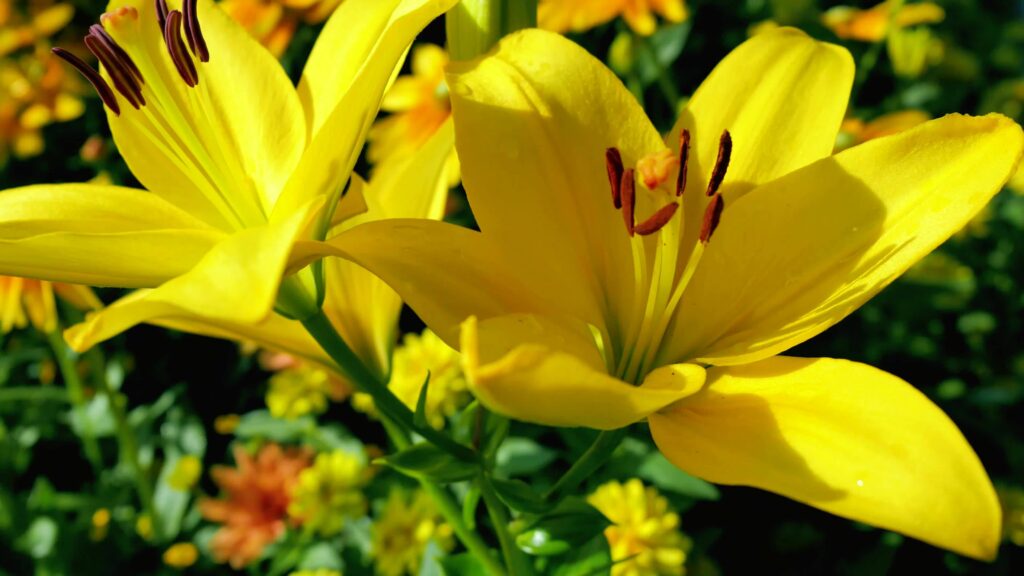
As beautiful as they are, belladonna lilies are also toxic.
©JOACHIM CH/Shutterstock.com
Poison Oak (Toxicondendron diversilobum)—Poison oak is a woody-stemmed shrub that typically reaches heights of 2-3 feet. Its leaves are typically dark green and feature three leaflets, similar to its distant cousin, the common oak. The leaves, stems, and roots of the plant contain oil that causes severe skin irritation upon contact.
Longleaf Milkweed (Asclepias longifolia)—Longleaf milkweed is a perennial wildflower found in the southeastern United States. It typically grows to a height of 2-3 feet and features narrow, lance-shaped leaves and clusters of pinkish-white flowers. All parts of this plant are poisonous if ingested, containing toxins that can cause severe digestive issues.
Belladonna Lily (Amaryllis belladonna)—Belladonna lily is a bulbous perennial that typically grows to heights of 1-2 feet. Its flowers are deep red and trumpet-shaped and it grows in pastures and rocky outcroppings. All parts of the plant are highly toxic, containing a variety of alkaloid compounds that can cause a number of serious health issues if ingested.
Summary of 6 Dangerous Plants That Grow in North Carolina
| Number | Dangerous Plant |
|---|---|
| 1 | Giant Hogweed |
| 2 | Poison Sumac |
| 3 | Horse Nettle |
| 4 | Poison Ivy |
| 5 | Water Hemlock |
| 6 | Poison Hemlock |
The photo featured at the top of this post is © AsepSur/Shutterstock.com
Thank you for reading! Have some feedback for us? Contact the AZ Animals editorial team.






